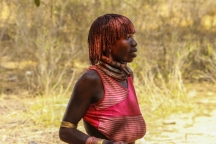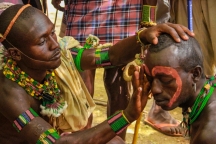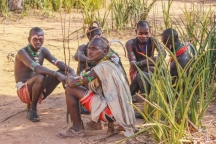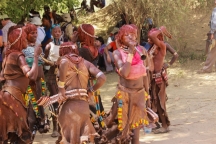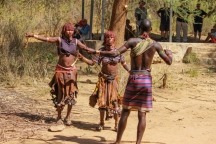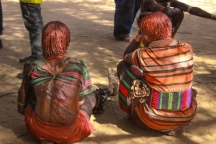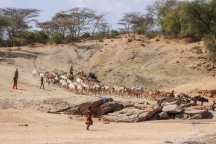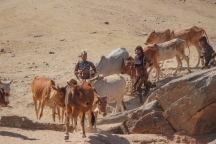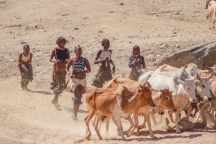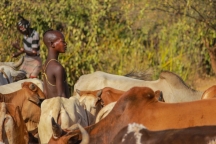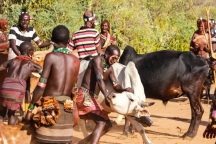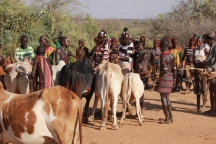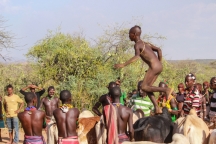Bull Jumping is the culmination of a three-day initiation ceremony, which every Hamer and Bena man goes through and it is a fascinating part of these Omo Valley tribes’ cultures. The tribes allow visitors to witness the bull jumping for a fee and the money you pay helps the jumper’s family with the cost of the ceremony. This allows the families to hold bull jumping earlier in the young man’s life. As a visitor, I found the Hamer ceremony fascinating, and recommend that any visitor to the area witness this.
Bull jumping takes place most often after the harvests, before the rainy season – February to April, but can happen at any time of the year. Sometimes it is mistakenly referred to as a wedding ceremony. Mistakenly, because bull jumpers can be as young as ten years old, if their family can afford this cost at such an age. Successfully passing a bull jumping does qualify the man to own cattle, marry and start a family, but that can take a few years.
Once the date of the ceremony is set, the initiate goes to the neighboring villages or markets to distribute invitations – strips of barks with a knot for each day left until the day of the jumping. The guest then unties one knot every day until all have been untied to indicate the date of the event.
Unmarried young men, who have already completed their bull jumping, but not yet married are called maza, which translates as “accomplished one”. They will be married once their parents find a suitable bride and are able to afford the dowry. Until marriage they live separately from the main tribe and travel between villages participating in bull jumping ceremonies. They play an important part in the event and are paid for their help in food and drink.
As the ceremony approaches, the women of the initiate’s family, except for his mother, start to dance and blow metallic horns, taunting the maza, who then whip them with birch sticks. This is by no means a gentle affair and the birch sticks often draw blood, leaving scars. Yet the women never make a sound and persist in the dancing and taunts. The intent of this tradition is for the women to show support for the jumper. As a grown man, he must repay this devotion by protecting them.
The initiate is stripped naked, except for two bark strings crossing his chest, and then scrubbed with sand to clean away his sins, and cow dung for strength. Finally, the bulls are brought in and lined up side by side. There can be as many as 30 animals in line and the maza keep the animals in place for the duration of the jumping ceremony. The jumper turns his back on the lineup and walks away, then runs up to the bulls jumps on the back of the first animal, holding his arms out to the sides for balance. He jumps across the backs of the bulls until he makes it to the other side of the lineup. Then he turns around and does it again. There are at least four runs until the ceremony is complete and the boy becomes a maza. But the initiate can do more, if he feels confident. If he fails to do the four runs, the initiate is embarrassed and does not get another attempt for another year. He is then given the name of the first bull in the lineup, dressed and lead off to celebrate his passage into manhood with sorghum beer and food with his family
There really is no way to guarantee seeing a bull jumping ceremony when you come to Hamer country, but it helps to have a good guide, who is familiar with the community and can find out if there are any taking place in the area. The ceremony I was fortunate enough to attend, thanks to our wonderful guide Emanuel (Emany) Cheneke took place on a dry river bed outside the town of Turmi and very close to a local lodge called Buska Lodge, and I am sure that the lodge staff would also know of any ceremonies in the area. With a little luck you will be able to see this fascinating event, but if you don’t – there are many other things that make the Omo Valley a wonderful destination.


